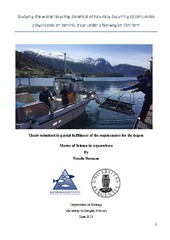| dc.contributor.author | Brennan, Natalie Briege | |
| dc.date.accessioned | 2018-08-14T15:12:11Z | |
| dc.date.available | 2018-08-14T15:12:11Z | |
| dc.date.issued | 2018-06-26 | |
| dc.date.submitted | 2018-06-25T22:00:14Z | |
| dc.identifier.uri | https://hdl.handle.net/1956/18091 | |
| dc.description.abstract | With an increasing salmon industry comes an increasing amount of waste released into the environment, impacting benthic environments in particular. This study investigated the potential of utilizing naturally occurring polychaetes to recycle fish waste on benthic trays placed on the seabed under a Norwegian fish farm. The four-week field study investigated the polychaete complexes under a deep (80-200m) salmon farm, identifying species composition and estimating their abundance and biomass. Video surveys were taken during the deployment period to document in situ epi-faunal polychaete development and spatial variation. Dominant species were then brought to the lab for physiological experiments to determine respiration rates, oxygen/nitrogen ratios and Respiratory Quotients (RQ). The lab and field data were used to calculate approximate carbon turnover rates for the dominant species. Capitella spp and M.fuliginsosus were found to colonize trays in low abundances, while Ophryotrocha spp was found to be the most abundant with rapid colonization rates (<6 days) in higher waste fall areas. Higher polychaete abundances were seen in areas with higher amounts of fish waste. Physiological experiments found all polychaetes were metabolizing a macronutrient source resembling a protein or lipid source and at the same metabolic rate. The RQ values found for Capitella spp (0.23), M.fuliginosus (0.31) and Ophryotrocha spp (0.25) were below the conventional range (0.6-1) and subsequent carbon turnover rate estimates were low for all species. Ophryotrocha spp were found to have the highest carbon turnover rate (2.54mg C/day/g AFDW). In order to decompose 20% of the POC coming down the biomass of Ophryotrocha would have to be 4 times that found in this study. It was concluded that the waste recycling potential of Ophryotrocha species in particular is worthy of further investigation. | en_US |
| dc.language.iso | eng | eng |
| dc.publisher | The University of Bergen | en_US |
| dc.subject | Akvakultur | nob |
| dc.subject | Bioremediering | nob |
| dc.subject | Flerbørstemarker | nob |
| dc.subject | Norge | nob |
| dc.title | Studying the waste recycling potential of naturally occurring polychaetes on benthic trays under a Norwegian fish farm | en_US |
| dc.type | Master thesis | |
| dc.date.updated | 2018-06-25T22:00:14Z | |
| dc.rights.holder | Copyright the Author. All rights reserved | en_US |
| dc.description.degree | Master's Thesis in Biology | en_US |
| dc.description.localcode | MAMN-BIO | |
| dc.description.localcode | BIO399 | |
| dc.subject.realfagstermer | https://data.ub.uio.no/realfagstermer/c006839 | |
| dc.subject.realfagstermer | https://data.ub.uio.no/realfagstermer/c030753 | |
| dc.subject.realfagstermer | https://data.ub.uio.no/realfagstermer/c013800 | |
| dc.subject.realfagstermer | https://data.ub.uio.no/realfagstermer/c013313 | |
| dc.subject.nus | 751999 | eng |
| fs.subjectcode | BIO399 | |
| fs.unitcode | 12-60-0 | |
